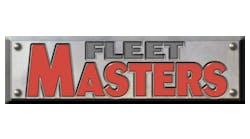During 2006-2007, Austin Bridge & Road experienced such significant growth that its management team decided to create a manual that would detail policy and procedures for the entire company. It would act as a ready reference for new hires.
Michael Munson, equipment director for the heavy-highway and infrastructure general contractor, says the purpose of the manual is to clearly define how things are done at Austin Bridge & Road, a unit of Austin Industries. This was even more essential given the fact that Austin Industries had become 100-percent employee owned in 2000.
Austin Bridge & Road is one of two winners of the 2010 Fleet Masters Award. The award is presented each year by Construction Equipment and the Association of Equipment Management Professionals (AEMP), and is judged on categories such as finance (financial management, acquisition, warranty and performance guarantees); information management (benchmarking, life cycle costing, specifications and technology); policies (safety, employee training, environmental and human resources); and controls (outsourcing, parts management, preventive maintenance and shop and facilities management).
Munson says the end result of the two-year undertaking was an all-encompassing compilation of the company’s best practices in procedures and policies. Entitled “The Austin Way,” the manual is designed to be accessed online. The sheer size of the tome can be quickly imagined by simply looking at the equipment section alone. That portion spans more than 500 pages that consist of 13 chapters covering a multitude of topics including capital expenditure, budgeting, preventive maintenance, repair services, financial reporting, and insurance.
For Munson, the manual could not have been timed better. It was nearing completion when he joined the company in 2009. The document reached the final editing phase his second day on the job.
“The steering committee for the manual was hosted by three vice presidents,” Munson says. “My boss was one of the vice presidents on that committee. He suggested I review the document to get a good understanding of the company.”
Since Munson was coming into the organization from a different industry, his boss also asked him to cast a critical eye on the document and, based on Munson’s past experience, “let him know if I had any suggestions to improve internal process, or if there was a way we could operate more efficiently,” Munson says.
“When I came on board, the manual enabled me to quickly get a feel for the entire organization,” he says. “I could access the document and actually walk through every process. It also helped me in making an analytical evaluation of the steps involved.”
Not only do new employees benefit from the book, but The Austin Way has proven to be an important asset to the company as well. “It was a great exercise for us since we had to determine if the processes were as efficient as possible,” Munson says. “By putting the process down on paper, we were forced to ask ourselves such questions as, ‘Is this truly the most efficient way to do it?’ In order to answer that question, we had to look at every one of our procedures.”
The biggest pay off was that “it created a resource for the entire company by detailing who was responsible for what. This was especially beneficial to the equipment department,” Munson says.
“If a manager out on a jobsite had questions about insurance or how to determine equipment rental rates or about the capital-acquisition process, the only way he could get the information was to pick up the phone and ask someone to walk him through the steps. Now he can go to the manual and view the full process. For instance, if you join the equipment department in haul management, you can go to that portion of the manual and get a full explanation of Austin’s haul procedures and how we do the billing.”
The same is true for any position throughout the company. If someone comes into accounts payable as a clerk, the manual provides that person with a step-by-step understanding of the accounts payable process and procedures.
To arrive at a true level of transparency, a number of gray areas had to be addressed, Munson says.
“Someone would say, ‘Well, this is my responsibility sometimes, but at other times it is someone else’s responsibility.’ The exercise of creating the manual forced us to determine precisely who is responsible for a particular item,” he says.
He cited this example: “The equipment fleet manager is responsible for recommending to senior management 1) updates to the current year capital expenditures report for construction equipment; 2) vehicle capital additions, replacements, capitalized repairs, and disposal of construction equipment to the plan year; and 3) vehicle replacements and disposals for the plan year.”
The director of equipment, on the other hand, “is responsible for leading the current year forecast and the plan-year capital expenditure budgeting process,” Munson says. “This includes reviewing the proposed plan, discussing plan requests and needs with the regional/operations managers and area manager, and providing guidance through industry expertise and equipment management skills.”
Regional/operations managers and area managers “are responsible for controlling equipment information needed for their regions/location by early August for annual capital expenditures budgeting. The information needed includes an update to the current year capital expenditures report and a detailed equipment needs list by project to be used for the plan-year budget.”
Once The Austin Way was completed, the next step was to ensure that all policies and procedures were followed.
“Because so many people were involved, it would be impossible to audit every single process, so we don’t have formal auditing,” Munson says. “It is the responsibility of leaders throughout the company to ensure that people follow The Austin Way. I know from experience that it is a great tool.”
In historical retrospect, the policies and procedures manual might be viewed as a period at the end of a sentence written in 1986 when the founders of Austin Industries decided the company should be 100-percent owned by its employees.





